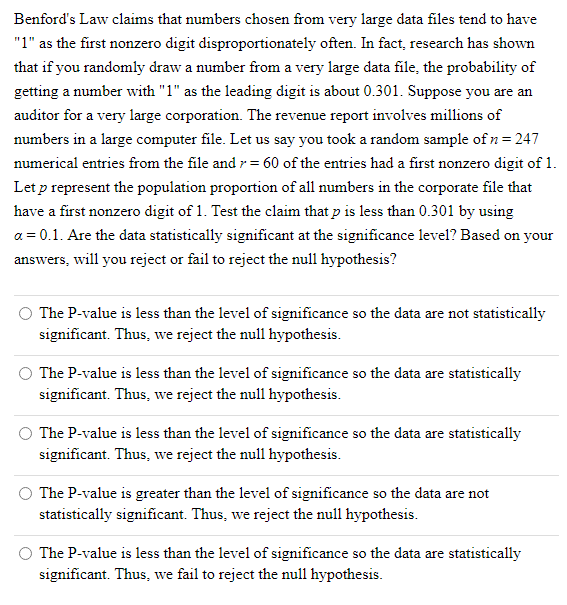andomly draw a number from a very large data file, the probability of getting a number with "1" as the leading digit is about 0.301. Suppose you are an auditor for a very large corporation. The revenue report involves millions of numbers in a large computer file. Let us say you took a random sample of n = 247 numerical entries from the file and r = 60 of the entries had a first nonzero digit of 1. Let p represent the
andomly draw a number from a very large data file, the probability of getting a number with "1" as the leading digit is about 0.301. Suppose you are an auditor for a very large corporation. The revenue report involves millions of numbers in a large computer file. Let us say you took a random sample of n = 247 numerical entries from the file and r = 60 of the entries had a first nonzero digit of 1. Let p represent the
College Algebra
7th Edition
ISBN:9781305115545
Author:James Stewart, Lothar Redlin, Saleem Watson
Publisher:James Stewart, Lothar Redlin, Saleem Watson
Chapter9: Counting And Probability
Section9.3: Binomial Probability
Problem 2E: If a binomial experiment has probability p success, then the probability of failure is...
Related questions
Question
Benford's Law claims that numbers chosen from very large data files tend to have "1" as the first nonzero digit disproportionately often. In fact, research has shown that if you randomly draw a number from a very large data file, the probability of getting a number with "1" as the leading digit is about 0.301. Suppose you are an auditor for a very large corporation. The revenue report involves millions of numbers in a large computer file. Let us say you took a random sample of n = 247 numerical entries from the file and r = 60 of the entries had a first nonzero digit of 1. Let p represent the population proportion of all numbers in the corporate file that have a first nonzero digit of 1. Test the claim that p is less than 0.301 by using α = 0.1. Are the data statistically significant at the significance level? Based on your answers, will you reject or fail to reject the null hypothesis?
Group of answer choices

Transcribed Image Text:Benford's Law claims that numbers chosen from very large data files tend to have
"1" as the first nonzero digit disproportionately often. In fact, research has shown
that if you randomly draw a number from a very large data file, the probability of
getting a number with "1" as the leading digit is about 0.301. Suppose you are an
auditor for a very large corporation. The revenue report involves millions of
numbers in a large computer file. Let us say you took a random sample of n = 247
numerical entries from the file and r = 60 of the entries had a first nonzero digit of 1.
Let p represent the population proportion of all numbers in the corporate file that
have a first nonzero digit of 1. Test the claim that p is less than 0.301 by using
a = 0.1. Are the data statistically significant at the significance level? Based on your
answers, will you reject or fail to reject the null hypothesis?
The P-value is less than the level of significance so the data are not statistically
significant. Thus, we reject the null hypothesis.
The P-value is less than the level of significance so the data are statistically
significant. Thus, we reject the null hypothesis.
The P-value is less than the level of significance so the data are statistically
significant. Thus, we reject the null hypothesis.
The P-value is greater than the level of significance so the data are not
statistically significant. Thus, we reject the null hypothesis.
The P-value is less than the level of significance so the data are statistically
significant. Thus, we fail to reject the null hypothesis.
Expert Solution
This question has been solved!
Explore an expertly crafted, step-by-step solution for a thorough understanding of key concepts.
This is a popular solution!
Trending now
This is a popular solution!
Step by step
Solved in 2 steps with 2 images

Knowledge Booster
Learn more about
Need a deep-dive on the concept behind this application? Look no further. Learn more about this topic, statistics and related others by exploring similar questions and additional content below.Recommended textbooks for you

College Algebra
Algebra
ISBN:
9781305115545
Author:
James Stewart, Lothar Redlin, Saleem Watson
Publisher:
Cengage Learning


Algebra & Trigonometry with Analytic Geometry
Algebra
ISBN:
9781133382119
Author:
Swokowski
Publisher:
Cengage

College Algebra
Algebra
ISBN:
9781305115545
Author:
James Stewart, Lothar Redlin, Saleem Watson
Publisher:
Cengage Learning


Algebra & Trigonometry with Analytic Geometry
Algebra
ISBN:
9781133382119
Author:
Swokowski
Publisher:
Cengage
